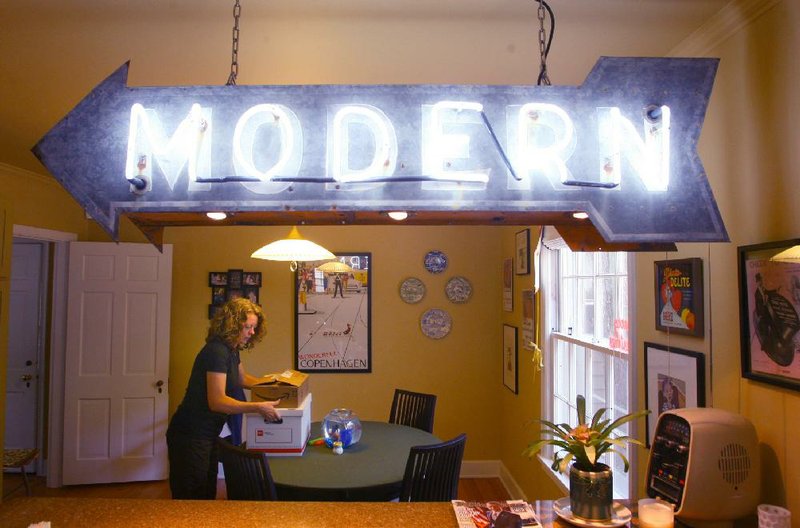LITTLE ROCK — Jill Curran lights her kitchen with a neon sign - a nearly 6-foot-long arrow, salvaged from the remains of a tourist court outside Hot Springs. The sign’s glowing letters of glass tubing proclaim: “Modern.” “I love it,” she says, “because it’s so not modern.”
Once upon a different time, the arrow called attention to a row of little homes-away-from-home.
Now, rusted to shabby chic, it points the way back to a past that fascinates her.
“Most people my age probably couldn’t tell what a tourist court was,” Curran, 47, says. Her dream is to have one. She imagines building a replica tourist court in her family’s back yard in Little Rock.
There, she could install another sign she collected from Hot Springs - “my favorite place,” she says, for its remnants of old tourist courts. The Spa City once had more than 80 such nests, according to the state expert on long-gone places to find a bed, namely her.
Curran has written, if not yet the book on tourist courts in Arkansas, at least the Encyclopedia of Arkansas’ entry on “Tourist Camps, Tourist Courts and Early Motels.”
She was project coordinator for the online compilation of state history. “Tourist camps and courts were a common form of lodging for travelers in the United States from the 1930s to the 1960s,” she writes at encyclopediaofarkansas.net.
Today’s motels cluster along the interstate, the same national chain names over and over, the same in-room coffeemakers, flat-screen TVs, free Wi-Fi access, few surprises.
Old-time travel was something else, each sleep stop being a separate and sometimes quirky operation. These are the places where Curran’s imagination checks in.
The sign she has in storage, and wants to restore, centers on the painted smile of a satisfied customer, a woman with hollow eyes. The eyes once beamed an electric glow - a strange welcome, it might seem, but yesterday’s travelers got used to odd sights.
Little recorded, motel history has gone the way of the coin-operated mattress that jiggled for a dime - as forgotten as the Coke machine with a lid on top. Back then, a wake-up call meant the guy at the front desk, maybe still in his bathrobe, called to say get up.
Curran traces how things evolved from the first sputterings of automotive traffic to this summer’s vacation road trips.
ON THE ROAD
Old-time train passengers stayed downtown at the hotel, Curran says. Car travelers were so entranced by the automobile, they practically wanted to sleep on the road. A night’s stay was any place the driver picked to pull over.
Towns along the way began to set up free campgrounds to encourage travelers to stop and spend. Private campgrounds charged for such fancier amenities as water. Progress came on wheels - from cars to cleaning carts.
An early-day tourist camp was basic ground space. Little Rock’s first tourist camp was in City Park (today’s MacArthur Park) in the mid-1920s, according to Curran’s research. It gave way to city’s first private camp, Lape’s, that charged for a night’s rest.
Once camp fees established that people were willing to pay for a roadside snooze, the competition was on to provide more and better services than the next guy. Lape’s offered actual rooms.
The word “court” held a special meaning to yesterday’s travelers, Curran says. It meant a private room. Add “modern” to “court,” and the room probably included a bath. Before long, people expected such over-the top luxuries as an electric fan.
The typical tourist court was a semicircle of cabins or cottages, none cuter than the Blue Bird Tourist Court outside of North Little Rock on the way to Memphis. The Blue Bird had 24 heated and cooled little houses with blue roofs and chirpy yellow awnings.
A vacation stay at a tourist court almost always inspired Dad to snap a picture of the family sedan in front of the cottage. Or, sometimes, the car tucked into its own little garage.
Curran explains the word “motel” as “a blend of motor and hotel.” Separate units gave way to one structure of many rooms, and the car went to a parking lot.
The trendy “motel” left the cozy “court” sounding so old fashioned, few courts survive. Old courts have gone the vanishing way of Route 66, “America’s Main Street,” as hard to find these days as a full-service gas station or a drive-in movie theater.
IF FOUND, DROP KEY IN ANY MAILBOX
Part of Curran’s interest comes from childhood memories of road trips and motel swimming pools (“I just love road trips”). And part comes from her discovery of motel memorabilia to be found online.
She collects postcards, room keys, ashtrays, dinky bars of soap, and the occasional highway sign. Even matchbook covers have lasted longer than most of the places they once advertised.
This one, for example, a matchbook from the “ultramodern” Trail 71 Motel in Bentonville: “You are a stranger here but once.” The cover shows a black rotary phone (“Give us a ring”). The number is CRestwood 3-4503, the way phone numbers used to have names, called exchanges, instead of area codes.
Yesterday’s traveler never thought to ask for a nonsmoking room. Every room had matches right beside the ashtray, such as this one in Curran’s collection: an ashtray from the Cotton Patch Motel in Little Rock (“Your comfort is our business”).
Motels typically were hardworking mom-and-pop businesses, such as the $1-a-night Rhodes Motel (“Arkansas’ newest and finest”) in Little Rock. The owners, Mr. and Mrs. Jack Rhodes, promised drive-in garages, radios and ceiling fans, to which they added their own cafe. Mr. Rhodes also ran a 24-hour gas station on the same premises, as described on the back of a Rhodes Motel postcard: “Service of all kinds while you sleep.”
Drivers found these places thanks to the handy guide books they picked up at gas stations and elsewhere along the highway. Curran’s collection includes this one, from 1941, that touts the Motel Monterey in Fayetteville for its “innerspring mattresses and box springs,” and the Harrison Motor Court in Harrison for being “well ventilated.”
BACK TO THE BEAUTYREST
“I was 5 when the Holiday Inn opened in North Little Rock,” Curran remembers.“It was the first indoor swimming pool I had seen in my life.”
The Holiday Inn chain started in 1952. Travelers already had learned to watch for Quality Courts and Best Western member motels to find the same standards upheld from one place to the next. With Holiday Inn came the expectation of the same accommodations. A person could leave his room, drive all day, and arrive at practically the same place.
So now, the traveler who stays at nothing but motels of the same chain is able to enter a new room, drop his suitcase without looking, and know before he hits the bed how many pillows are there to catch him.
But Curran wonders how it would have been to stay at the Ashdown Motel in Ashdown, where the matchbook cover promised the place was fireproof. At the King Tut Court in Little Rock, which had nothing apparent to do with Egyptian royalty, but boasted a nice stand of shade trees. At Little Rock’s “luxuriously furnished” Rose Courts, where each room had a flower trellis.
And of course, all these and more were as the arrow sign guarantees:
“Modern.”
Style, Pages 25 on 07/17/2012


